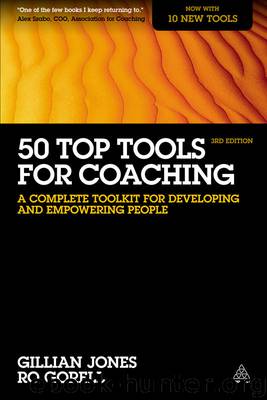50 Top Tools for Coaching: A Complete Toolkit for Developing and Empowering People by Gillian Jones & Ro Gorell

Author:Gillian Jones & Ro Gorell
Language: eng
Format: mobi, azw3
Publisher: Kogan Page
Published: 2015-09-02T14:00:00+00:00
Prioritizing values
What is it?
Having established what your clients’ values are, it is now important to understand how they prioritize them and which ones are likely to be their core values. This tool takes the output from the values tool above and enables clients to evaluate which of their values are most important.
What is it for?
Understanding the relative importance clients attach to their values means that when they meet a value obstacle they can explore where that value comes on the prioritizing table and what lies behind the obstacle. They can then choose what actions, if any, to take. It is extra information that they have about them that allows them to understand how and why they make decisions. It also helps them to understand why they might experience natural discomfort about something (see Tables 5.6 and 5.7).
Over the course of the coaching relationship the prioritized values help the coach and the client make sense of behaviours and what motivated those behaviours in the first place. For example, understanding that something made you angry because it violated one of your values enables you to make sense of it and decide whether or not it was a useful and appropriate emotion for that situation. This can be especially helpful when coaching people with strong emotional responses to situations and can help them make different choices in the future while maintaining integrity around their values. In the same way, it can be helpful to coach clients who value cool-headedness and self-restraint highly and who have had feedback about their lack of ability to express how they feel and connect with others. By holding up the mirror of the clients’ values and exploring how they can ensure that their values remain intact, they are able to interact with others in a way that maintains the other people’s values.
A lot can be gained from this simple tool. There are many other ways in which understanding prioritized values can be used to help shape coaching conversations. These suggestions are based on experiences we’ve had using this tool. Experiment with it and use it to understand your own prioritized values. Coaching people is not only a collaborative process; in coaching others we experience our own insights and so both parties benefit from the conversations to help each other develop and grow.
When do I use it?
This tool is designed to be used following the previous tool (see ‘Determining values’ above).
What is the process?
Using the prioritizing values tool in Table 5.6, ask clients to list their values down the left-hand column and repeat these values in the same order across the top line of the table. For example, if ‘learning’ is one of their values, they would put ‘learning’ in box a on the left-hand column and box a in the top line.
TABLE 5.6 Prioritizing values
Download
50 Top Tools for Coaching: A Complete Toolkit for Developing and Empowering People by Gillian Jones & Ro Gorell.azw3
This site does not store any files on its server. We only index and link to content provided by other sites. Please contact the content providers to delete copyright contents if any and email us, we'll remove relevant links or contents immediately.
Hit Refresh by Satya Nadella(8856)
The Compound Effect by Darren Hardy(8513)
Change Your Questions, Change Your Life by Marilee Adams(7377)
Nudge - Improving Decisions about Health, Wealth, and Happiness by Thaler Sunstein(7244)
The Black Swan by Nassim Nicholas Taleb(6770)
Deep Work by Cal Newport(6563)
Daring Greatly by Brene Brown(6227)
Rich Dad Poor Dad by Robert T. Kiyosaki(6179)
Principles: Life and Work by Ray Dalio(5962)
Man-made Catastrophes and Risk Information Concealment by Dmitry Chernov & Didier Sornette(5650)
Playing to Win_ How Strategy Really Works by A.G. Lafley & Roger L. Martin(5506)
Digital Minimalism by Cal Newport;(5392)
Big Magic: Creative Living Beyond Fear by Elizabeth Gilbert(5354)
The Myth of the Strong Leader by Archie Brown(5239)
The Slight Edge by Jeff Olson(5200)
Discipline Equals Freedom by Jocko Willink(5157)
The Motivation Myth by Jeff Haden(5005)
Stone's Rules by Roger Stone(4860)
The Laws of Human Nature by Robert Greene(4778)
